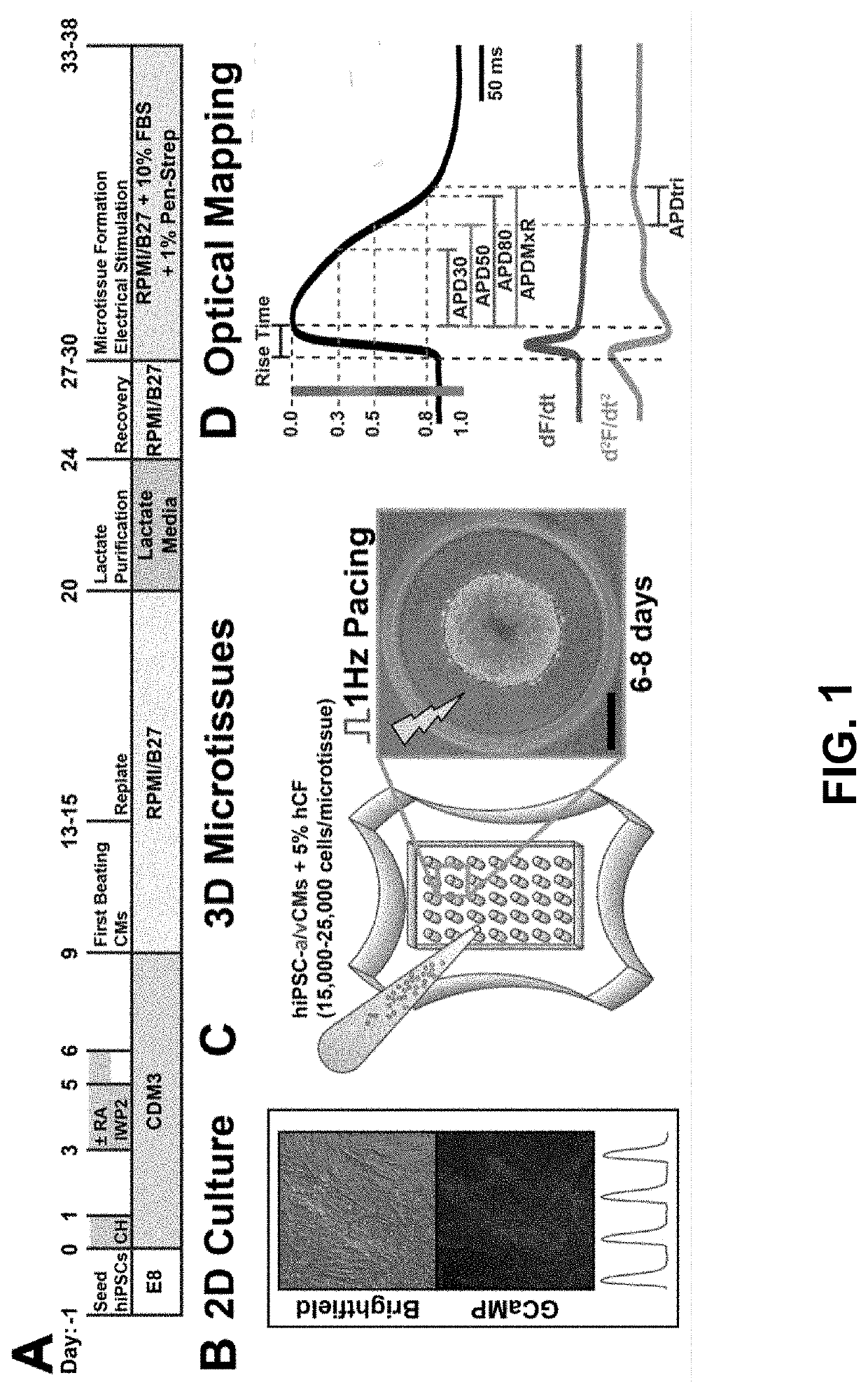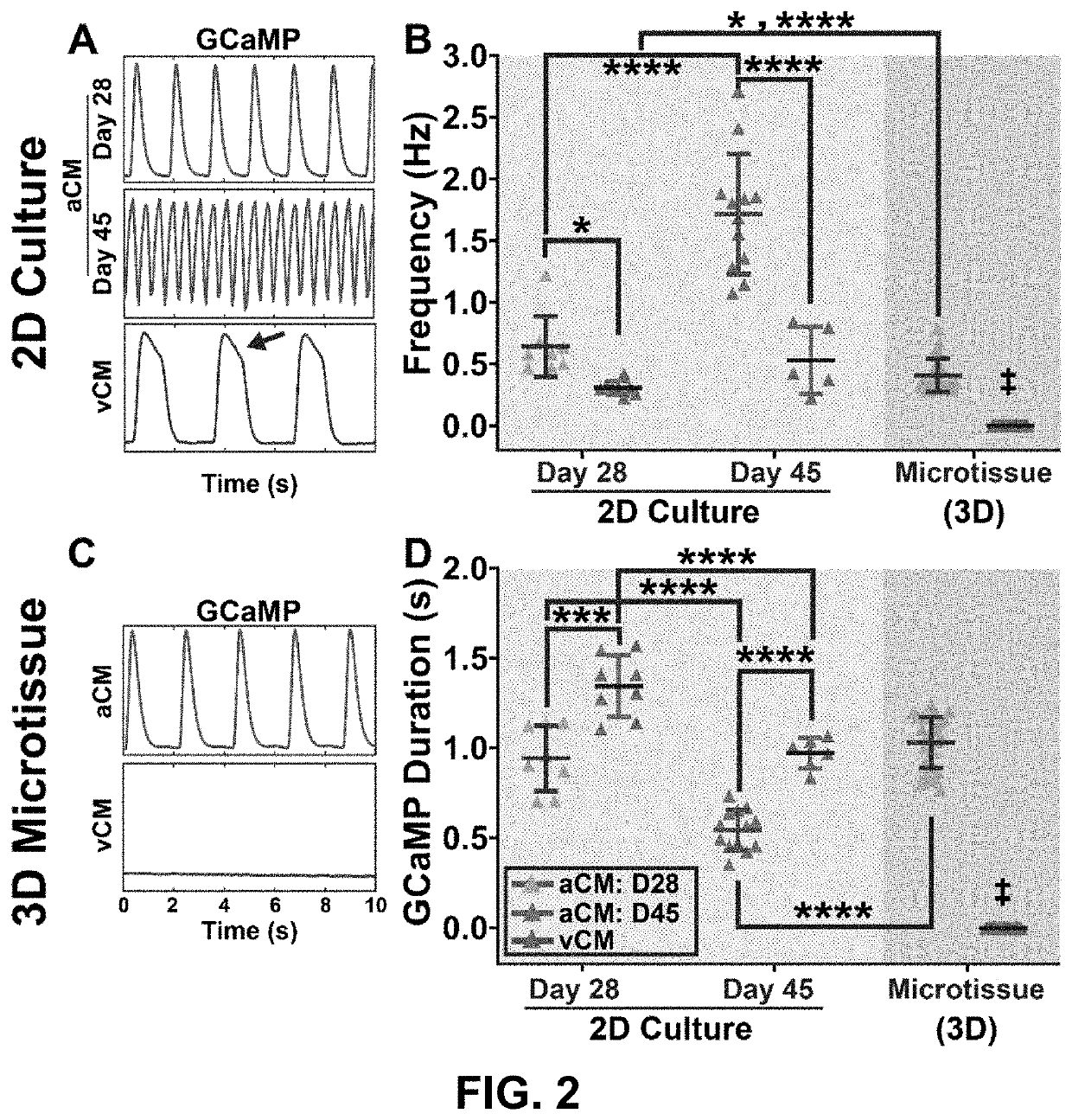Atrial cardiac microtissues for chamber-specific arrhythmogenic toxicity responses
a technology of arrhythmogenic toxicity and cardiac microtissues, which is applied in the field of cardiac microtissues for chamber-specific arrhythmogenic toxicity responses, can solve the problems of affecting the accuracy of ablation target identification, and affecting the effect of ablation efficiency
- Summary
- Abstract
- Description
- Claims
- Application Information
AI Technical Summary
Benefits of technology
Problems solved by technology
Method used
Image
Examples
example 1
Atrial Differentiation and 3D Cardiac Microtissue Generation Protocol
Protocol Adapted From:
[0118](1) GiWi Protocol: Lian et al., Nat Proc, (2013).
[0119](2) Atrial Differentiation: Cyganek et al., JCI Insight (2018.
[0120](3) 3D Cardiac Microtissues: Soepriatna et al., Cell Mol Bioeng, (2021).
[0121](4) Kofron et al., Science Reports (2021).
Reagents / Materials: General Reagent:
[0122]DPBS, No Calcium, No Magnesium (ThermoFisher, Catalog#: 14190144)
[0123]Fetal Bovine Serum (FBS) (ThermoFisher, Catalog#: 16000044)
[0124]Penicillin-Streptomycin (Pen-Strep) (Sigma, Catalog#: P0781)
Reagents / materials: For Plate Coating:
[0125]Vitronectin (VTN-N; 500 μg / mL) (ThermoFisher, Catalog#: A14700)
[0126]Coat 10 cm tissue culture plate with 5 μg / mL VTN-N (1:100 dilution in DPBS).
[0127]Coat for one hour at room temperature or overnight in humidity chamber at 4° C.
[0128]Matrigel™, Growth Factor Reduced (Fisher, Catalog#: CB356238)
[0129]Coat 24 / 12 / 6 tissue culture well-plate with 1× Matrigel™ (diluted in DME...
example 2
Platform for Atrial Arrhythmia Risk Assessment
[0240]Cardiomyocyte subtype, maturation state, and structural organization influence spontaneous beating rates. Retinoic acid supplementation at days 3-6 of differentiation yielded cardiomyocytes with significantly reduced MLC2v expression compared to those without retinoic acid supplementation (MLC2v+aCM=18±5 vs. MLC2v+vCM=31±0.2, paCM=83±5% vs. cTnT+vCM=89±5%, p>0.05; FIG. 6). Fluorescence imaging of calcium transients in 2D monolayer cultures without electrical stimulation showed that spontaneous activity varied with cardiomyocyte subtypes, with atrial cardiomyocytes demonstrating faster automaticity than ventricular cardiomyocytes at day 28 of differentiation (freqaCM,D28=0.64±0.25 Hz vs. freqvCM,D28=0.31±0.06 Hz, p<0.05; FIG. 2A and FIG. 2B).
[0241]Interestingly, in a small batch of differentiation where the inventors cultured cardiomyocytes for up to forty-five days, we measured a significant increase in spontaneous beating rates in...
example 3
Fibroblast Staining of 3D Microtissues
[0248]The inventors obtained representative photographic images of a 3D cardiac microtissue stained with cardiac troponin I (cTnI), vimentin, and Hoechst. The images confirmed the presence of a low percentage of fibroblasts distributed throughout the microtissue. Immunohistochemical staining on monolayer cultures of either cardiomyocytes or fibroblasts with both cTnI and vimentin confirmed that input hiPSC-cardiomyocytes positively stain for cTnI, as observed by striations on the yellow inset while staining negative for vimentin.
PUM
 Login to View More
Login to View More Abstract
Description
Claims
Application Information
 Login to View More
Login to View More - R&D
- Intellectual Property
- Life Sciences
- Materials
- Tech Scout
- Unparalleled Data Quality
- Higher Quality Content
- 60% Fewer Hallucinations
Browse by: Latest US Patents, China's latest patents, Technical Efficacy Thesaurus, Application Domain, Technology Topic, Popular Technical Reports.
© 2025 PatSnap. All rights reserved.Legal|Privacy policy|Modern Slavery Act Transparency Statement|Sitemap|About US| Contact US: help@patsnap.com



